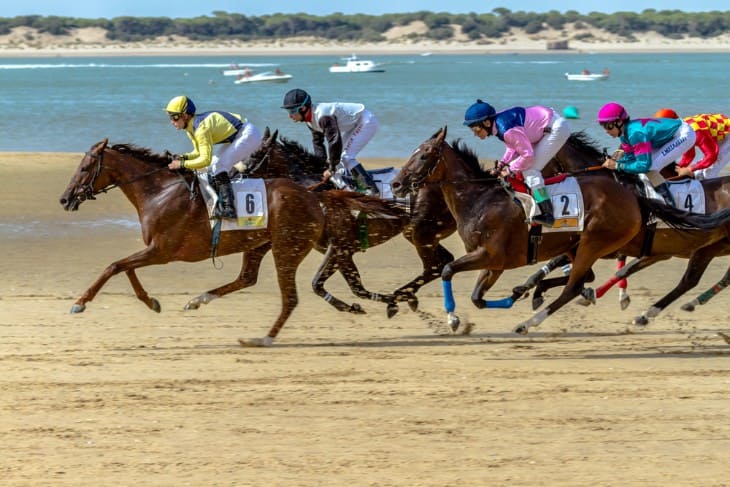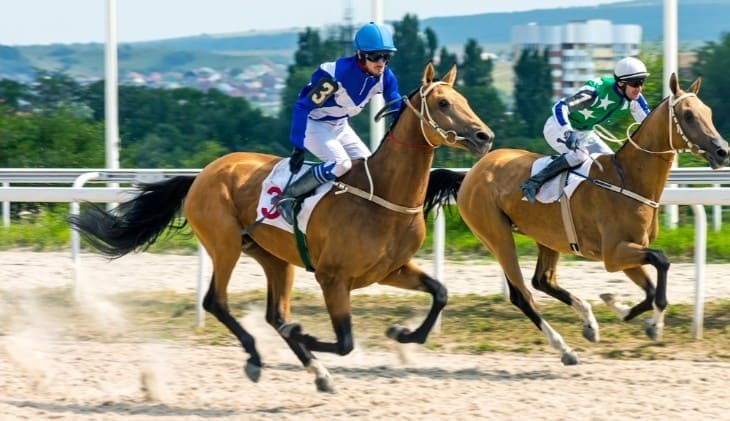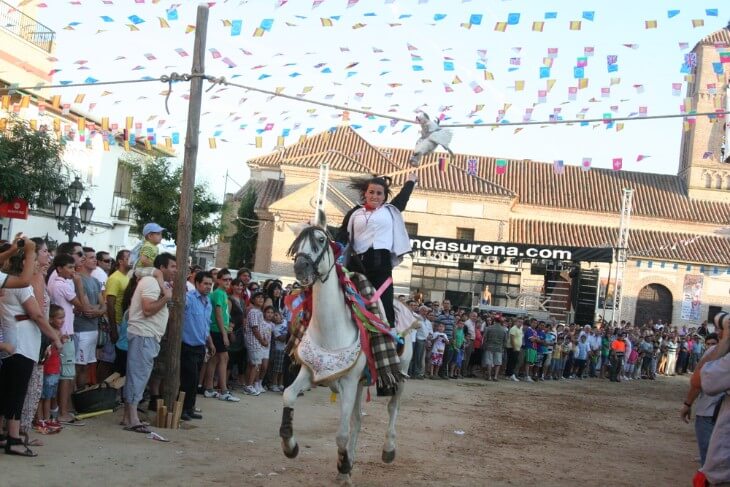Introduction
When did horse racing start? We may not know the exact answer but we know for sure its history spans thousands of years. Horse racing is one of the oldest sports in the world, with a history dating back to ancient civilizations. The origins of horse racing can be traced back to ancient civilizations in various parts of the world, and that’s why we are going on a quick journey, to learn more about the history of this beautiful sport.
Horse racing in ancient civilizations, particularly ancient Greece and Rome, held cultural and sporting significance and was a spectacle enjoyed by the masses. Horse racing was a source of entertainment, excitement, and pride. It showcased the skills of charioteers and the speed and agility of horses. These ancient racing traditions laid the foundation for the development of horse racing in later centuries, shaping the sport into what it is today.
Ancient Greece:
Olympic Games: Horse racing was one of the main events in the ancient Olympic Games, which were held in Olympia, Greece, starting from 776 BCE. The races took place in the hippodrome, a stadium-like structure specifically built for chariot and horse racing.
Chariot Racing: Chariot racing was immensely popular in ancient Greece. The races involved two-wheeled chariots pulled by teams of horses, and the charioteers competed fiercely for victory. These races demanded exceptional horsemanship and strategic manoeuvring.
Hippodrome: In addition to the Olympics, various Greek cities had their own hippodromes where horse racing events were held regularly. These events were not only athletic competitions but also social and cultural gatherings, drawing spectators from different city-states.
Ancient Rome:
Chariot Racing: Chariot racing was a major spectator sport in ancient Rome. The Circus Maximus, a massive chariot racing stadium in Rome, could accommodate hundreds of thousands of spectators. There were different factions, each represented by a colour, and fans were passionately devoted to their favourite teams and charioteers.
Circus Maximus: The Circus Maximus was the largest and most famous chariot racing venue in Rome. Chariot races here were intense, often leading to accidents and collisions, adding to the excitement of the sport.
Political and Social Impact: Chariot racing in Rome was not just a form of entertainment but also had political and social implications. Factions often had political affiliations, and races could influence public opinion and the political climate of the city.
Endurance Races: Apart from chariot racing, there were also endurance races where horses were raced over long distances. These races tested the stamina and speed of the horses and were a testament to their breeding and training.
Arabian Peninsula
Horse racing in the medieval Arab world was deeply ingrained in the culture and daily life of the Bedouin tribes. The emphasis on endurance and meticulous breeding practices led to the creation of the Arabian horse breed, which remains highly regarded in the equestrian world today. The legacy of Arab horse racing endures through the continued popularity of endurance racing and the influence of Arabian horses on diverse horse breeds worldwide.
1. Arabian Horse Breeding:
Selective Breeding: Arab nomads practised selective breeding to develop the Arabian horse breed. These horses were bred for their speed, endurance, and strength, making them ideal for long-distance racing.
Bedouin Tradition: The Bedouin tribes, particularly in the Arabian Peninsula, played a crucial role in preserving and enhancing the Arabian horse breed. Horses were highly valued and often considered a measure of a tribe's wealth and prestige.
2. Endurance Racing:
Bedouin Competitions: Endurance racing was a common form of horse racing among Bedouin tribes. These races were typically long-distance events covering vast desert terrain, emphasizing the horse's ability to endure harsh conditions.
Practicality and Survival: Endurance racing wasn't just a sport but also a practical necessity. Bedouins relied on horses for transportation and survival, making endurance a key trait in their horses.

3. Cultural Significance:
Poetry and Literature: Horses, including racehorses, were celebrated in Arabian poetry and literature. Arab poets composed verses praising the speed and grace of their horses, contributing to the cultural significance of horse racing.
Symbolism: Horses held symbolic importance in Arab culture, representing strength, freedom, and nobility. This symbolism further elevated the status of horse racing and horses in general.
4. Legacy and Influence:
Spread of Arabian Horses: Arabian horses, renowned for their speed and endurance, were highly sought after and traded across different regions. They played a significant role in shaping various horse breeds worldwide through crossbreeding.
Modern Endurance Racing: The endurance racing tradition of the medieval Arab world has influenced modern competitive endurance riding, which continues to be a popular equestrian sport globally.
Horse Racing in Medieval England
If we are talking about horse racing in the form we know today, the best place to look for is medieval England. This is pretty much where horse racing did start. While medieval horse racing in England was not as systematic as contemporary racing, it laid the foundation for the sport's evolution. The informal races among the nobility and local communities contributed to the enduring popularity of horse racing, eventually leading to the establishment of the Jockey Club in the 18th century and the standardization of rules and regulations in the sport.
1. Noble Pursuit:
Nobility and Aristocracy: Horse racing was primarily an activity enjoyed by the nobility and aristocracy in medieval England. Wealthy landowners and royalty often engaged in friendly competitions to showcase their best horses.
2. Informal and Localized:
Informal Nature: Horse racing in medieval England was far less formal than contemporary racing. Races were often impromptu events held on open fields, common grounds, or straight stretches of roads.
Local Competitions: These races were usually localized affairs within specific communities or regions. Villages and towns would organize races for entertainment during fairs and festivals.
3. Prize Money and Bets:
Prize Offerings: While there were no official racecourses or governing bodies, small prizes or rewards were sometimes offered to the winners. These prizes could include money, goods, or even land in some cases.
Betting Culture: Betting on horse races, even in its early forms, was common. Spectators often placed informal bets on the outcomes of races, contributing to the competitive and social aspects of the events.
4. Horse Breeding and Selection:
Selective Breeding: Even in medieval times, there was a recognition of the importance of breeding in horses. Nobles and landowners selectively bred horses to improve their speed and endurance, leading to the development of specific local horse breeds.
War Horses: Horses were not only used for racing but also for military purposes. Strong and swift horses were highly valued for knights and cavalry in battles.
5. Royal Patronage:
Royal Interest: The English monarchy displayed interest in horse racing. Kings and nobles sometimes owned stables and participated in racing events, promoting the sport among the elite classes.
6. Evolution Over Time:
Transition to Modern Racing: Over time, horse racing in England transitioned into a more organized and regulated sport. The 16th and 17th centuries saw the emergence of formal racecourses, and rules began to be established, leading to the structured horse racing we recognize today.
19th Century United States
The 19th century was a transformative period for horse racing in the United States. The sport's growth, the emergence of professional participants, the establishment of prestigious races, and the development of organized racing institutions laid the foundation for the modern horse racing industry in the country.
1. Growth and Popularity:
Rapid Expansion: Horse racing gained widespread popularity and experienced rapid growth during the 19th century. The sport became a prominent form of entertainment, attracting large crowds from diverse social and economic backgrounds.
Urbanization: With the rise of cities and urban centres, horse racing tracks were established in various metropolitan areas, contributing to the sport's accessibility and popularity.
2. Thoroughbred Racing:
Importance of Thoroughbreds: Thoroughbred racing became the predominant form of horse racing in the United States. Thoroughbred horses, known for their speed and stamina, were imported from England and other European countries, shaping the American racing landscape.
Kentucky: Kentucky, especially the Bluegrass region, became a centre for Thoroughbred breeding. The state's fertile soil and favourable climate made it an ideal place for raising racehorses. The Kentucky Derby, first run in 1875, quickly became one of the most prestigious races in the country.
3. Rise of Professional Jockeys and Trainers:
Professionalization: The 19th century witnessed the rise of professional jockeys and trainers. Skilled riders and trainers became highly sought after, and their expertise played a crucial role in the success of racehorses.
African American Jockeys: Many skilled jockeys in the 19th century were African Americans. African-American jockeys had a significant presence in horse racing during this time, with several achieving fame and success in major races.
4. Betting Culture:
Pervasive Betting: Betting on horse races became deeply ingrained in American horse racing culture. Wagering on races was common, and bookmakers operated at racecourses, facilitating betting activities.
Impact of Betting: The betting culture not only fueled the financial aspects of horse racing but also added an element of excitement and competition, drawing more spectators to the tracks.
5. Racetracks and Organizations:
Establishment of Racetracks: Formal racetracks with proper facilities and grandstands were constructed in various states, providing spectators with comfortable viewing areas.
Jockey Club Formation: The formation of Jockey Clubs and racing organizations helped standardize rules, regulate the sport, and ensure fair competition. The American Stud Book, established in 1868, recorded Thoroughbred pedigrees, enhancing the integrity of horse racing.
6. Technological Advancements:
Advancements in Timing: Technological innovations, such as improved timing methods, added precision to races. Accurate timing systems and photo finishes contributed to fair and transparent outcomes.
Modern Form of Horse Racing
If we talk about the sport we know today, the answer to the question “When did horse racing start” would be the 19th century. Horse racing began to take its modern form in the 19th century with the establishment of organized racing institutions, standardization of rules, the creation of formal racecourses, and the emphasis on Thoroughbred breeding. Several key developments contributed to shaping horse racing into the recognizable sport we know today:

1. Establishment of Formal Racecourses:
Purpose-Built Tracks: Purpose-built racetracks with standardized dimensions and conditions were constructed. These tracks provided consistent surfaces for racing and allowed for fair competition.
Grandstands and Facilities: Racetracks began to feature grandstands, spectator facilities, and amenities, enhancing the overall experience for racegoers.
2. Standardization of Rules and Regulations:
Jockey Clubs: The formation of Jockey Clubs in various countries, such as the Jockey Club in England (founded in 1750) and the American Jockey Club (founded in 1894), played a significant role in standardizing rules and regulations. These clubs established guidelines for horse eligibility, race distances, and conduct on the track.
3. Emphasis on Thoroughbred Breeding:
Thoroughbred Racing: Thoroughbred horses, with their exceptional speed and stamina, became the focal point of horse racing. Selective breeding practices led to the development of a distinct Thoroughbred breed, which dominates the racing world today.
Pedigree Records: Pedigree records were meticulously maintained, ensuring the purity of Thoroughbred bloodlines. The American Stud Book, established in 1868, is one of the oldest and most comprehensive Thoroughbred stud books.
4. Professional Jockeys and Trainers:
Professionalization: The emergence of professional jockeys and trainers contributed to the sport's development. Skilled riders and trainers brought expertise and strategy to the races, enhancing the competitive nature of horse racing.
5. Technological Advancements:
Timing and Photography: Advancements in timing methods and the introduction of photo finish technology ensured accurate results. Electronic timing systems and high-speed cameras became standard tools for determining race outcomes.
6. Globalization of Major Races:
International Competitions: Major races, such as the Kentucky Derby in the United States, the Epsom Derby in England, and the Melbourne Cup in Australia, gained international recognition. These races attracted participants and spectators from around the world, fostering a global racing community.
Modern Era and Globalization
The modern era of horse racing, particularly from the mid-20th century onward, has been marked by significant advancements and globalization.
1. Technological Advancements:
Electronic Timing: The introduction of electronic timing systems allowed for precise measurement of race times, ensuring accurate records and fair competition.
Photo Finish Technology: High-speed cameras and photo finish technology became standard, enabling officials to determine race outcomes with incredible precision, especially in closely contested races.
2. Broadcasting and Media:
Television Coverage: The advent of television brought horse racing into people's homes, expanding its audience base significantly. Major races began to be broadcast live, allowing fans worldwide to watch races from different countries.
Online Streaming: In the digital age, horse racing events are streamed online, making them accessible to a global audience. Fans can watch races and place bets from anywhere with an internet connection.
3. Global Racing Calendar:
International Competitions: Major races, such as the Prix de l'Arc de Triomphe in France, the Dubai World Cup in the United Arab Emirates, and the Japan Cup in Japan, became prestigious international events, attracting top horses, trainers, and jockeys from around the world.
World Series of Racing: Initiatives like the Breeders' Cup in the United States created a series of high-stakes races, bringing together elite horses and creating a global championship event.
4. Breeding and Bloodstock:
International Bloodstock: Horses are frequently bought, sold, and transported across borders. International buyers invest in horses from different countries, leading to a global exchange of bloodlines and breeding practices.
Stallion Syndication: Elite racehorses, especially successful stallions, are often syndicated internationally, allowing breeders from various countries to access superior bloodlines for their breeding programs.
5. Regulations and Anti-Doping Measures:
Uniform Regulations: International efforts have been made to standardize regulations related to horse welfare, medication use, and race integrity. Organizations like the International Federation of Horseracing Authorities (IFHA) work to establish global standards.
Anti-Doping: Stricter anti-doping measures have been implemented to ensure fair competition and maintain the integrity of the sport.
6. Global Betting Markets:
Online Betting: The rise of online betting platforms has facilitated the participation of bettors from different countries in horse racing events worldwide. This has contributed to the growth of the sports betting markets on a global scale.
7. Social and Cultural Impact:
Tourism and Events: Major racing events have become significant tourist attractions, drawing visitors from different countries and contributing to the local economy.
Cultural Exchange: Horse racing has become a cultural exchange platform, with people from diverse backgrounds coming together to celebrate the sport and its traditions.
Summary
Horse racing has a rich history dating back to ancient civilizations, including Greece, Rome, and the medieval Arab world. In the 19th century, the sport evolved significantly, leading to the establishment of organized racing institutions, standardized rules, and formal racecourses. The modern era of horse racing, from the mid-20th century onwards, witnessed globalization through technological advancements, international competitions, and the exchange of bloodstock. Today, horse racing is a global sport with a widespread audience, facilitated by television, online streaming, and international racing events, shaping a dynamic and culturally diverse industry.
For more information:
Sizing up Horse Racing Competitions: Local vs National vs International
The Role of the British Equestrian Federation in Horse Racing








